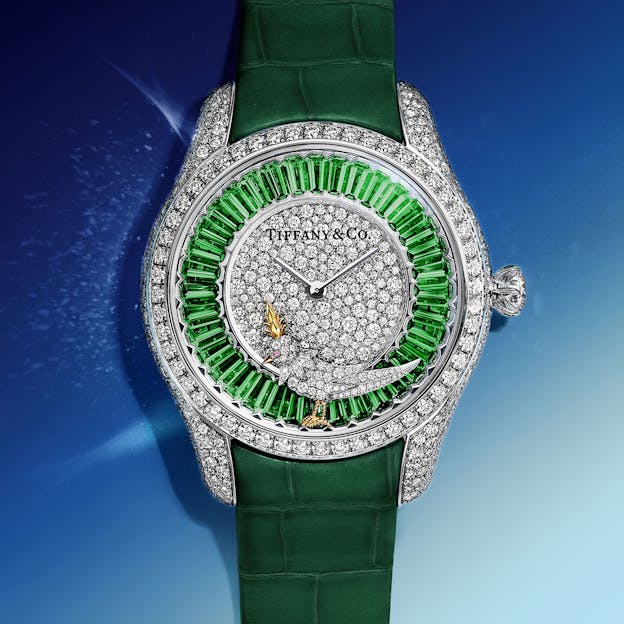LVMH Watch Week: Tiffany & Co. Debuts Drop Dead Gorgeous, Opulent High Jewelry Timepieces
Tiffany looks to the future by reconnecting with its iconic roots.
If you live in New York, it’s easy to forget that there’s more to Tiffany & Co. than just the flagship on 5th and 57th, and Holly Golightly. Tiffany was acquired by LVMH in 2019, is a global luxury powerhouse, with over 300 locations, and the flagship was renovated post-LVMH acquisition in a four year major makeover that saw the entire interior revised, refreshed and modernized, although the original façade remained untouched. The flagship was also the headquarters for LVMH during LVMH Watch Week 2025, with all of the watch brands relocating their exhibits after the wildfires in Los Angeles forced the Group to cancel its event, originally scheduled for LA. I have to give the Tiffany team a lot of credit for making the show look and feel as if it was scheduled for New York all along.

That corner is also home to the BVLGARI New York flagship, and on the same block of 57th Street, you can find the LVMH temporary flagship, with its five storey high stacks of LVMH trunks, as well as, across the street, a skyscraper-sized stack of Louis Vuitton trunks acting as the façade for a renovation of the main LVMH New York boutique. During LVMH Watch Week, sub-freezing cold and gusts that turned 57th Street into an urban wind tunnel didn’t stop crowds of tourists from taking selfies in front of the façade.

The new pieces that Tiffany & Co. showed were just as much flagships as the boutique. All timepieces are high jewelry works of art for the wrist and are full-throated proclamations of Tiffany’s history and heritage as one of the great names in the history of jewelry, and of the design work of Jean Michel Schlumberger, who began designing for Tiffany in 1956 at the request of then-president Walter Hoving, and who continued to produce designs for Tiffany until his retirement in the 1970s.

This year is the first in which Tiffany has participated in LVMH Watch Week, but based on the new releases, Tiffany will moving forward be as prominent as a watch manufacturer as it is a jeweler – although its history and competences as a jeweler are an intrinsic part of the watch designs.
The Jean Schlumberger By Tiffany Bird On A Rock
The “Bird On A Rock” brooch is one of Schlumberger’s most famous design for Tiffany & Co. and was inspired by a yellow cockatoo Schlumberger saw outside his home in Guadalupe. Over the years, there have been many versions of the design, including one that saw the bird perched atop the “Tiffany Yellow” diamond, one of the largest yellow diamonds in the world, which is still owned by Tiffany and which has since its discovery in 1877, been worn by only four women: Mary Whitehouse (at the 1957 Tiffany Ball) Audrey Hepburn in 1961, in the marketing campaign for “Breakfast At Tiffany’s” and then by Lady Gaga and Beyoncé.

Two versions of the watch were announced; both have freely rotating inner dials which carry the bird. The version with an inner dial of aquamarine is 36mm and quartz powered, while the version with an inner dial of tsavorite is 39mm and powered by the automatic caliber LTM 2100 (LTM is Le Temps Manufacture, located in Fleurier).

The Jean Schlumberger By Tiffany Twenty Four Stone Watch

The Twenty Four Stone watch uses a design motif which was originally created as a wedding ring by Jean Schlumberger in 1959, and, according to Tiffany, was inspired by Schlumberger’s family’s “roots as textile manufacturers” in Alsace. The design uses gold, cross-stitch pattern threads in order to separated and highlight the diamonds and was first launched as the Sixteen Stone Collection.
As with the Bird On A Rock watches, the Twenty Four Stone watch has an inner rotating dial which rotates freely as the wearer moves their wrist. The case is 39mm, in white gold, with yellow gold cross-stitches and the inner rotating dial is set with 24 brilliant cut diamonds. The movement is the same automatic caliber LTM 2100 used in the Bird On A Rock watches.
The Eternity by Tiffany Wisteria Watch
Tiffany fans will almost certainly already be familiar with Tiffany’s famous “Wisteria” table lamp, which was designed by the celebrated Tiffany glass artist Clara Driscoll (1861-1944) who designed over thirty lamps for Tiffany, and who was the head of the Tiffany Studios Women’s Glass Cutting Department. The Wisteria lamp required the hand cutting and setting of some 2,000 pieces of glass and, five years after its introduction in 1901, the Wisteria lamp sold for $400, which was a year’s salary for the average American worker; it was one of Tiffany’s most expensive lamps Tiffany sold.

Translating the Wisteria lamp design into a watch involved creating a dial also made of glass – however, in the watch the glass is fired or vitreous enamel. Enamel is prepared by grinding the glass into a very fine powder in a mortar and pestle and then applying it to a metal surface; if the areas of enamel are separated by walls of flattened gold wire, you have cloisonné enameling (probably the most common type of enameling found in watches) and if the enamel is deposited in shallow engraved cells, you have champlevé enameling.


For the Wisteria watch, a relatively rare type of enameling known as plique-à-jour was used, which is essentially a miniature form of stained glass. It’s considered technically more challenging as unlike other types of enameling, there is no metal backing. This allows the light to shine through the enamel but also requires great care on the part of the enamelist.

The dial is then set with twelve 1.9 carat diamonds before being incorporated into the watch. The finished timepiece is 38mm in diameter, in white gold, and also uses the LTM 2100 caliber.

Each of the hour markers uses a different diamond cut: round brilliant, baguette, cushion, Tiffany True®, marquise, Asscher, heart, pear, oval, emerald, triangle and princess.
The Tiffany 128 Carat Aquamarine
All of the above watches are going to be series produced, but in very small numbers yearly, thanks to the amount of work involved in such processes as gem selection, cutting, polishing and setting, and in the case of the Wisteria watch, the amount of work involved in creating the plique-à-jour dial and cutting twelve large diamonds in twelve different cuts for the hour markers. The Tiffany 128 Carat Aquamarine, on the other hand, is a unique piece and one look will tell you why.

The 128 Aquamarine’s bracelet just taken by itself would be a lavishly luxurious piece of jewelry, but it’s the crystal of the watch that really sets the 128 Aquamarine apart. As the name says, it’s a single, 128 carat aquamarine gemstone, faceted to reflect the cut of the famous Tiffany Yellow diamond, which was shown at the same time as the 128 Aquamarine.

Tiffany already had watches in its catalog with faceted sapphire crystal dials but this is obviously horological gem-setting on a completely different level. It’s hard to overstate the impact these watches (and, Lord knows, the Tiffany Yellow) have in person. Gemstones are obviously valuable objects and they draw the eye with irresistible visual magnetism, but it’s hard not to feel something akin to a supernatural presence, especially in larger stones and most especially in the Tiffany Yellow, which was one of the few objects in the room that stood a chance of out-shining the watches its design had inspired. They feel like not just luxury objects, but cultural objects as well and they stand for everything you hope Tiffany means when you think of the name, and its history, and what it means to the history of jewelry and design.
Find out more, and explore some of Tiffany’s other high jewelry timepieces, at Tiffany.com.

